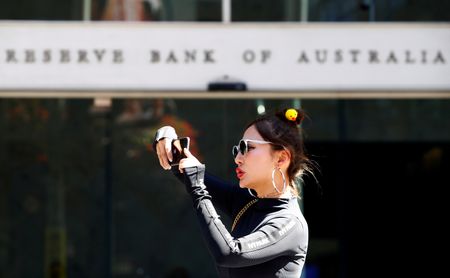
By Devayani Sathyan and Vivek Mishra
BENGALURU (Reuters) – Australia’s central bank will end its longest easing cycle on record by the end of the third quarter, according to a Reuters poll in which a growing minority of economists expected a rate hike just weeks after a federal election in May.
When several of its peers have already tightened policy, including the U.S. Federal Reserve, which is expected to deliver multiple 50-basis-point hikes this year, the Reserve Bank of Australia (RBA) has been waiting for signs wage inflation is picking up.
Money market traders have bet on an RBA move in June, just weeks after the May election, given expectations high commodity prices and global supply constraints caused by the Russia-Ukraine war will increase inflation.
“The timing of the election is a complication for the RBA,” wrote Felicity Emmett, senior economist at ANZ.
“While the Bank will lift rates if the case is compelling, no matter the timing, (RBA Governor Philip) Lowe would likely prefer not to raise rates either just before or just after an election. The RBA did cut rates in 2019 just after the election, but cutting is much more palatable than hiking.”
In the latest March 28-31 Reuters poll, the median forecast showed the RBA would raise its official cash rate from 0.10% to 0.50% by the end of the July-September quarter, compared with to 0.25% in a March poll.
However, economists were split on how the RBA would proceed.
A growing number expected the first rate hike by end-June, with 9 of 35 forecasting rates at 0.25% by then and three calling for rates at 0.50% by the end of the second quarter.
Just under half of respondents, 16 of 35, forecast rates to go up to 0.50% by end-September, with 12 calling for 0.25%. Three said rates would still be at 0.10% while four economists expected the cash rate to reach 0.75%, where it was before the pandemic.In response to an additional question on which month the RBA will start its first hiking cycle in over a decade, 12 of 27 said August and ten said June.
The remaining five were nearly divided between September and November. Among the major local banks, CBA is tipping a first rise in June, Westpac and NAB see August, ANZ said September.
“We see every meeting as live from May, with our expectation for a first hike of 15 basis points in August followed by two further hikes in 2022,” said Alan Oster, chief economist at NAB.
While median forecasts showed the benchmark rate would rise to 0.75% by the end of this year, eight economists expect it to reach 1.00%.
More interest rate rises are on the way, with rates reaching 1.75% by the end of next year, up from 1.25% predicted in the previous survey.
Some economists said the federal budget walked a thin line between providing too much stimulus in the near term that could pressurise the RBA to move sooner than expected.
“We still expect inflation to approach 5% by Q3 and the additional stimulus measures announced add to the upside risks. With the government doing nothing to restrain demand, the RBA will have to do the heavy lifting to rein in inflation,” said Marcel Thieliant, economist at Capital Economics.
The poll showed inflation would remain well above the RBA’s target range of 2%-3% until the end of this year.
It was expected to average 4.2% this year and slip to 2.8% in 2023, a massive upgrade from 2.5% and 2.3% predicted in January.
Australia’s economy was expected to grow 4.2% this year and 2.8% in 2023.
(For other stories from the Reuters global long-term economic outlook polls package:)
(Reporting by Devayani Sathyan and Vivek Mishra; Analysis and polling by Arsh Mogre and Md Manzer Hussain; Editing by Ross Finley and Barbara Lewis)

